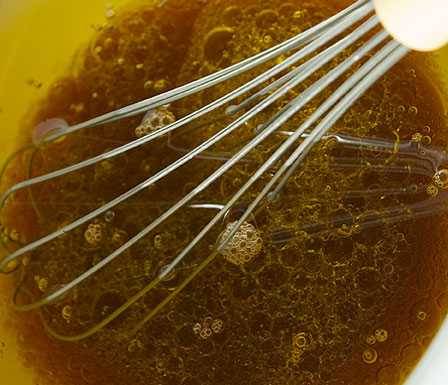Oil and acid are the building blocks most salad dressings and marinades, especially oil and vinegar, a time honored blend called a vinaigrette. There are infinite variations on the theme. You can just use oil and vinegar alone, swap the types of vinegar, substitute lemon juice, add fresh herbs, dried herbs, spices, add honey or other sweeteners, and riff them any which way. The classic ratio is three parts oil to one part vinegar, but you might want less vinegar if you chose one that is especially high in acid, or increase it if you use a sweet vinegar like a tradizione balsamico.
But oil and water don’t get along, and vinegar is mostly water. Oil is hydrophobic (repulsed by water). Mix them together, shake as hard as you wish, and by the time the cruet gets from the head of a table of eight to the last person, they have separated. Worse, pour them on your salad, and they run off and settle to the bottom.
Oil and vinegar are like Spencer Tracy and Katherine Hepburn in most of their romantic comedies. They start out hating each other, but if something brings them together, a surfactant or an emulsifier, something that can break the repulsion, they cling to each other and the salad greens beautifully.
An emulsifier/surfactant coats the oil molecules and makes it easier for them to mix with the watery stuff. Mustard is a common emulsifier for home made salad dressings. Mayonnaise is also an emulsifier, as are egg yolks, and honey. Commercial dressings often use xanthan gum, lecithin, or dairy extracts.
Because there are infinite variations on the basic vinaigrette, I’m not going to give you a lot of different salad dressing recipes. I’m going to give you one that I use often. My wife, LT, came up it and we riff on it all the time. Experiment with the base formula to make your own. The finished products will keep in the fridge for months.



High quality websites are expensive to run. If you help us, we’ll pay you back bigtime with an ad-free experience and a lot of freebies!
Millions come to AmazingRibs.com every month for high quality tested recipes, tips on technique, science, mythbusting, product reviews, and inspiration. But it is expensive to run a website with more than 2,000 pages and we don’t have a big corporate partner to subsidize us.
Our most important source of sustenance is people who join our Pitmaster Club. But please don’t think of it as a donation. Members get MANY great benefits. We block all third-party ads, we give members free ebooks, magazines, interviews, webinars, more recipes, a monthly sweepstakes with prizes worth up to $2,000, discounts on products, and best of all a community of like-minded cooks free of flame wars. Click below to see all the benefits, take a free 30 day trial, and help keep this site alive.
Post comments and questions below
1) Please try the search box at the top of every page before you ask for help.
2) Try to post your question to the appropriate page.
3) Tell us everything we need to know to help such as the type of cooker and thermometer. Dial thermometers are often off by as much as 50°F so if you are not using a good digital thermometer we probably can’t help you with time and temp questions. Please read this article about thermometers.
4) If you are a member of the Pitmaster Club, your comments login is probably different.
5) Posts with links in them may not appear immediately.
Moderators